Cougars (Puma Concolor) are sometimes called Mountain Lions, Panthers, Pumas, or Catamounts. Mountain Lions were common in the Catskill Mountains in the 1700's and 1800's. They were hunted to extinction in the 1800's and early 1900's. Around 1900, New York State paid a large bounty for each Mountain Lion killed in the Catskill Mountains. Around 1930, all of them were hunted to extinction.
Male mountain lions average around 130 pounds with ranges of 115 to 160 pounds. In rare cases, they can go as high as 250 pounds. Females average around 90 pounds with a range of 75 to 105 pounds. Mountain Lions are FIVE times large then a Bobcat. They are usually around 24-to-30 inches high. They are range from 5-to-9 feet long from the nose to the end of their long tails. They are tan in color and have a short hair. Their tracks are similar to a bobcat, but they are approximately twice as large. The paw print is about the size of a man's hand (about 4 inches). They can leap vertically as high as 18 feet. They can leap horizontally from 20-to-40 feet. They can leap across a street without ever touching the road. Mountain Lions do NOT roar like a African Lion. They do hiss, growl, chirp, and scream.
Mountain Lions favorite prey are deer. But, they will also take horses, sheep, bobcats, coyotes, raccoons. porcupines, rabbits, mice, or any animal it can catch. They will by stalking and ambushing their prey when they least expect them. After they have closed in, they will race towards the prey by running up to 50 mph and jumping on the prey. They will attempt to knock down and surprise the prey.
Controversy over allegations of DEC Releasing Mountain Lions
The most accurate version of the story goes like this: In or about 2001 appoximately eleven mountain lions were released in Rensselearville, NY (southwest Albany County) by the DEC. In 2007 or 2008 more mountain lions and grey wolves were released in Columbia County by the DEC. The DEC denies that this happen, and has posted numerous statements on their website that they never did this.
At the turn of the century, there were a number of eastern states that considered a repopulation of Cougers. When public forums were performed they were met with very aggressive opposition from the community. This killed all of the plans to reintroduce Mountain Lions into eastern states. Some believe that the NYS DEC then decided to secretly release them without public knowledge. The DEC aggressively denys that this happen.
The controversy started when a horse was attacked and killed in Albany County. The owner of the horse did research and determined that the horse was killed by a Mountain Lion. When the owner called the DEC, the DEC dismissed the owner, and clung to the statement that Mountain Lions do not exist in New York, so any suggestion that the horse was killed by a Mountain Lion is false. In the past, the DEC has acknowledged that people do, and have, released Mountain Lions that become too large to handle. But, the DEC alleged that this could not be the case here. The DEC insisted that a coyote killed the horse. This enraged the owner, and he started a campaign to support his theory. The owner posted pictures and research to support his theory on a web site, and posted ads asking for evidence of a Mountain Lion. Looking back, the DEC took the position of stone-walling and and denying the convincing evidence of a Mountain Lion attack. The DEC's answer was not believable. It didn't take long before the owner learned of the alleged 2001 release of Mountain Lions in Rensselearville, which was close to the attack of the horse. Some of the people who came forward of the release were extremely credible. From this point on, statements from the DEC were not believable, nor credible. It made it appear that the DEC was conducting a coverup of a secret release of Mountain Lions. From this point forward, the story continued to grow.
In the first DEC statement about mountain lions, they continued to make the statement that Mountain Lions do not exist naturally in New York State. They also stated that sometimes people with good intentions bring Mountain Lion cubs into New York State. When the cubs grow up, they become uncontrolable and they release them. Sometimes people with permits keep Mountain Lions, and they escape from their enclosures. Mountain Lions found in the wild in New York State are usually from either of these two possible sources. But, if a male and female mountain lion are illegally released, it is highly likely that a substained population would start, and continue to to grow.
At some point a web site started to display images of "proof" of mountain lions in New York. The DEC then created a web site page to discredit an Email campaign of "proof" of Mountain Lions in New York. You can read that page here. Some of the facts on the page are incorrect, but the point is that none of the photos were taken in New York. We agree with the DEC on this fact. Many of those picture are listed on this page. It should also be noted that none of the Mountain Lions on this page were taken in New York. The exception is the blurry picture that appears to be a Mountain Lion. We will discuss this picture later.
The DEC also published an article in, "The Conservationist" February 2008 issue. The article, "Investigating Cougar Sighting in New York" by Scott Van Arsdale. Scott does make a number of valid points and statements. But sadly, he titles the article with "Big Cat Tales", which makes the reader believe that he is making fun of the possibility of mountain lions existing in New York. This attitude continues with some of his 44 reporting of mountain lions turning out the be domestic kitty cats. While some people don't know what a mountain lion looks like. The article doesn't mention that some people know exactly what a mountain lion looks like. We had no problem finding more then 44 people who have alleged to have seen a mountain lion in New York. Some of them were very credible. It may be that many people are now not reporting any evidence. We found most of our sources refused to contact the DEC with sighting or physical evidence. Within a year, we were twice led to mountain lion tracks, which we were able to confirm as mountain lion tracks. The article goes on to say that the Adirondacks have heavy automoble traffic, so mountain lions could not survive there. We found this statement not believable. There are many locations on the west coast that have heavier traffic and the mountain lions are never hit. Furthermore, the Catskills would be a far better habitat then Adirondacks. Both Mountain Lions and the Lynx were found in much higher densities in the Catskill Mountains then the Adirondacks in 1700's and 1800's. The premise that there would be a significant amount of road kill if they existing is not believable. Florida does have a high road kill problem, but the parameters are much different. While the article is interesting and informative, here is also siginifcant information left out of the article. And, the article makes it appear that the author is part of the campaign to deny the existance of mountain lions in New York. He doesn't come off as impartial as you would expect of a professional biologist.
The NY DEC's official position is that Mountain Lions do not exist in New York. Unofficially and privately, they will acknowledge that there is some roaming around. The NYS DEC aggressively alleges that Mountain Lions do not exist naturally in New York State. We would agree with this statement. While New York State alleges that the last one was killed in 1894. There are some credible historical records that state that some may have existed up into the 1920's. But, we agree that by 1930 there were none left in the wild in New York. But, the DEC is not willing to acknowledge that mountain lions may have been illegally, accidentally, or naturally reintroduced. And, that they may be living, reproducing, and substaning in New York. When Mountain Lions are found or killed, the DEC claims that they were pets who were illegally released by their owners or escapees. This may be true in some cases. Over the past couple of years. Mountain Lions have been seen in Delmar, Coeymans, Cooperstown, Coxsackie, Hunter, Newburg, Hartwick, Saratoga, Speculator Lake, Stamford, Raquette Lake, and many other locations. One was killed by a farmer in Coxsackie, and removed by the DEC. A mountain lion was seen running across Rt 214 in the winter of 2009. The mountain lion was tracked across the Indian Head Mountain Range, and across the Huckleberry Trail. The Kaaterskill Mountain Range is an ideal habitat for Mountain Lions.
A number of years ago, the The Kingston Freeman ran an article of a Mountain Lion Found in Hartwick, New York. Attached to the article was a picture of the cat. At first glance it does look like a mountain lion. But, after comparing it to an almost identical picture of a Bobcat, we concur with the DEC. It is most likely a Bobcat. The tail does not appear to long, but it does appear to be bobbed like a Bobcat. But, the tail does not have the signature black tip of a Bobcat. The tail does not answer the question. The right ear does look identical to a Bobcat. while mountain lions do have a little whiteness to their ear, it is not as white as shown in the picture. This is the most compelling evidence that it is a Bobcat. The picture also shows a large white streak on the lower neck. Mountain lions do not have this, so again it make the picture look more like a Bobcat. If it was a mountain lion you would expect it to be bigger in the picture. Mountain Lions are five times large then a Bobcat. You can look at both of the pictures below:
 |
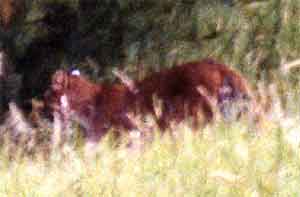 |
 |
Alleged Cougar - Actually a Bobcat |
 |
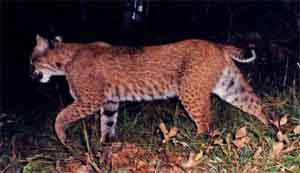 |
 |
Bobcat |
Did the DEC secretly release mountain lions in New York? Did someone illegally release a breeding pair, and they are reproducing? Did mountain lions naturally roam into the New York without anyones knowledge? That is for you to decide. New York State DEC's official position is that mountain lions do not exist in New York under any circumstances (excluding captive ones). But, it is hard to deny the substancial number of the reports of credible sighting. In 2010, the New York DEC changed their position to they do not believe that there is a breeding pair of mountain lions in New York. We agree with this statement. This is the kind of statement you would expect from a professional biologist. For a professional biologist to claim that mountain lions exist in New York, solid evidence has to be collected and examined. This evidence would be a high resolution photograph that can be proven that it was taken in New York; Evidence of off-spring; clear and convincing tracks. The burden of proof is much higher for biologist. Only time will answer this question. Meanwhile, mountain lions continue to move from the west to the east more-and-more each year. It is only a matter of time before they show up. Right now, they are known to be in Michigan.
How do I know if Mountain Lions are nearby?:
Paw Prints in the snow or mud.
Large leaps in the snow (20+ feet).
Large jumps in the snow (12+ feet).
If a mountain lion is around you, it is very unlikely you will ever see it. They are experts at not being seen or heard. If you look at the picture on the left you will see a mountain lion directly behind a deer. Deer can here very well. The best way to find mountain lions is looking for paw prints in the snow. They have large paws that are approximately 4 inches in diameter. While there are dogs with similar paws, which can be confused with mountain lions, dogs don't make large leaps that mountain lions do. A mountain lion can leap 20-to-40 feet in a single bound. In Glacier National Park in Northwest Montana, there are Mountain Lions around Avalanche Lake. Each year, they see the paw prints, but know one ever sees them, but they are there. They are very reclusive and avoid people. They are extremely good at not being detected. Mountain Lions are known to watch people and prey walk by them, and then follow up behind them. Mountain Lions are ambush predators. They will often cover their prey, most likely deer, with grass to cover it up. But, Bobcats also do this, so you cannot presume that a covered deer carcass was killed by a mountain lion. A mountain lion paw print is 4 inches in diameter, and about the size of a man's large palm. Below is the actual size of a Mountain Lion Print:
What to do if you encounter a Mountain Lion:
Never EVER run from a Mountain Lion. This WILL result in your death!
Act large, and throw sticks and stones at it to try and scare it away.
If you have multiple people - stand side-by-side
If you encounter a Mountain Lion, there are some things you should and shouldn't do. Never EVER run from a Mountain Lion. I cannot state this strongly enough. Running from a Mountain Lion will instinctively make them chase you, and attack you, and kill you. You should act large as possible. Do not try to hide. Do not crouch down. You need to make the Mountain Lion realize that you are bigger and stronger then they are. If you have children, put them behind you. If you have multiple adults, have then stand side-by-side to appear bigger and stronger then they are. Throw sticks and stone at it. Yell at it to scare them away.
What to do if you attacked by a Mountain Lion:
Use Bear Spray if you have some.
Fight back as strong as you can - Absolutely do NOT play dead!
Keep the Mountain Lion's mouth away from your neck, throat, and skull - this is how they will kill you.
If the Mountain Lion gets a hold of your neck or skull, stick your finger in it's eye.
If traveling with multiple people, fight the Mountain Lion as a group.
If another person has bear spray, and someone is being attacked, spray both the Mountain Lion and the person.
Mountain Lions rarely attack people, but it does happen. If you can spray a Mountain Lion with bear spray, this will prevent an attack. If you are attacked, you should fight for your life. Absolutely do NOT play dead! Playing dead will result in your immediate death! Mountain Lions kill people in three ways: (1) Grabs the back of your neck with it's mouth and snaps your neck; (2) Grabs your throat and suffocates you to death; (3) Grabs your skull and bites thru your skull and kills you instantly. You want to do everything to prevent them from getting to those three areas of your body. They will use their front legs and paws to knock you down or knock your arms out of the way. Most people never even see the Mountain Lion charging up behind them. Some people just see a flash of the Mountain Lion. If the Mountain Lion grabs you in a fatal area, stick your finger into it's eye. If you are with multiple people, attack the Mountain Lion as a group. This is the most successful way of surviving. If you stand back, then Mountain Lion will attack you after they are done with the first person. The mortality rate of attacks are that 25% are fatally killed, and 75% survive.
|
 |
 |
 |
Cougar |
 |
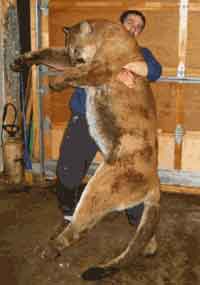 |
 |
Dead Cougar killed by a car in the Dakotas |
 |
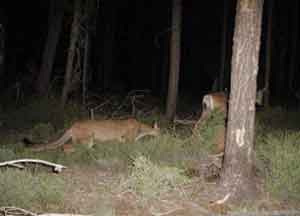 |
 |
Cougar stalking a deer in the Dakotas |
 |
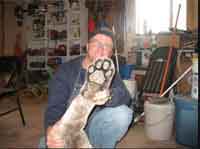 |
 |
Paw of a Cougar in the Dakotas |
|

